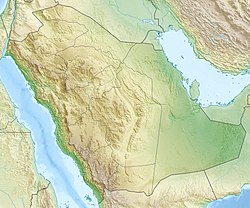Ar-Riyadh
|
Riyadh الرياض |
||||||
|---|---|---|---|---|---|---|
| Capital city | ||||||
Clockwise from top left:
National Museum of Saudi Arabia, Masmak fort, King Khalid International Airport, Riyadh skyline in the evening seen from Al Faisaliyah Center with Kingdom Center in the back, Ministry of Interior building |
||||||
|
||||||
| Location of Riyadh within Saudi Arabia | ||||||
| Coordinates: 24°38′N 46°43′E / 24.633°N 46.717°ECoordinates: 24°38′N 46°43′E / 24.633°N 46.717°E | ||||||
| Country |
|
|||||
| Government | ||||||
| • Riyadh Prince Governor | Faisal bin Bandar Al Saud | |||||
| • Mayor | Ibraheem Mohammed Al-Sultan | |||||
| Area | ||||||
| • Total | 1,798 km2 (694 sq mi) | |||||
| Elevation | 612 m (2,008 ft) | |||||
| Population (2016) | ||||||
| • Total | 6,506,700 | |||||
| • Density | 3,600/km2 (9,400/sq mi) | |||||
| Time zone | AST (UTC+3) | |||||
| • Summer (DST) | AST (UTC+3) | |||||
| Postal Code | (5 digits) | |||||
| Area code(s) | +966-11 | |||||
| Website | High Commission for the Development of Riyadh Riyadh Municipality | |||||
Riyadh (/rɨˈjɑːd/; Arabic: الرياض ar-Riyāḍ Najdi pronunciation: [er.rɪˈjɑːðˤ]) is the capital and most populous city of Saudi Arabia. It is also the capital of Riyadh Province and belongs to the historical regions of Najd and Al-Yamama. It is situated in the center of the Arabian Peninsula on a large plateau and home to more than six million people.
The city is divided into 15 municipal districts, managed by the Municipality of Riyadh headed by the mayor of Riyadh, and the Development Authority of Riyadh which is chaired by the governor of the Province, Faisal bin Bandar Al Saud. The current mayor is Ibrahim Mohammed Al-Sultan. Riyadh has been designated a global city.
During the Pre-Islamic era the city at the site was called Hajr (Arabic: حجر), and was reportedly founded by the tribe of Banu Hanifa. Hajr served as the capital of the province of Al Yamamah, whose governors were responsible for most of central and eastern Arabia during the Umayyad and Abbasid eras. Al-Yamamah broke away from the Abbasid Empire in 866 and the area fell under the rule of the Ukhaydhirites, who moved the capital from Hajr to nearby Al Kharj. The city then went into a long period of decline. In the 14th century, North African traveller Ibn Battuta wrote of his visit to Hajr, describing it as "the main city of Al-Yamamah, and its name is Hajr". Ibn Battuta goes on to describe it as a city of canals and trees with most of its inhabitants belonging to Bani Hanifa, and reports that he continued on with their leader to Mecca to perform the Hajj.
...
Wikipedia







